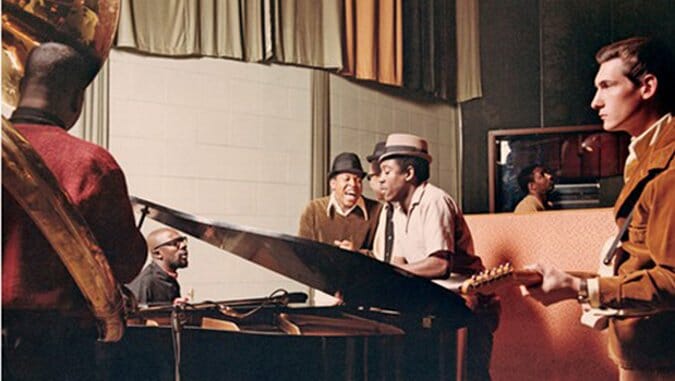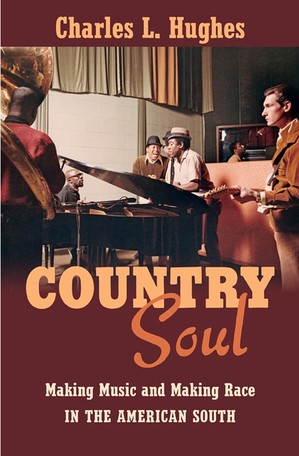
The many petulant responses to the landmark civil rights film Selma remind us that white moviegoers often prefer their black stories sweetened with white heroes. We’ve seen the box office reliability of that approach demonstrated in films of questionable historical balance from Cry Freedom to Mississippi Burning to The Help. Likewise, as Charles Hughes explains in Country Soul: Making Music and Making Race in the American South, the “first generation” of scholarship on southern soul music comforted white readers with a triumphant story of interracial cooperation, and a handful of white heroes that guided (or, as Hughes would argue, misguided) the narrative.
Peter Guralnick’s seminal Sweet Soul Music (1986) tells the story of Memphis soul largely through the eyes of white Stax Records guitarist Steve Cropper, a key figure in the studio’s legendary integrated house band, Booker T. and the M.G.’s, that helped produce dozens of hits for black artists. Guralnick also identifies white songwriter-producer Dan Penn as Sweet Soul Music’s unsung “white hero,” emblematic of the connections he draws between soul music’s integrated origins and the “southern dream of freedom.” In several stunningly productive years of interracial in-studio harmony, according to Guralnick, just about the only guy to rock the boat was a black non-musician named Ted White, first husband of Aretha Franklin. White’s drunken antagonism toward white musicians ruined Franklin’s first (and, as it turned out, only) recording session in Rick Hall’s legendary FAME Studios in Muscle Shoals, Ala. The incident nearly derailed the recording of her classic first album on Atlantic Records, I Never Loved a Man the Way I Love You.
To a large extent, while telling an essential part of the story, those early southern soul books presented white heroes and black talents, who came together not only to make groundbreaking music but also to model interracial equality and integration with an ease and fluidity rarely seen outside the studio walls in the American South at that time. Soul music’s peak period offers the heart-in-the-right-place wishful thinker an almost-too-tantalizing confluence of historical forces. The classic era of southern soul spans roughly 1963-68—not only pivotal years in the civil rights movement, but also the years in which white and black musical tastes aligned more closely than ever before, and arguably ever since. The popularly held belief that the legendary southern soul performers of that era—Otis Redding, Aretha Franklin, Solomon Burke, Wilson Pickett, Sam & Dave, Percy Sledge—recorded their biggest hits with either all-white or integrated studio bands, also rings true. And the studios at the center of it all took pride in promoting themselves as beacons of interracial cooperation. That golden era ended bitterly, so the Cropper-Guralnick story goes, when the assassination of Martin Luther King, Jr. in 1968 brought new hostilities into the studio, as the push for integration gave way to Black Power, and black musicians lost their tolerance for working with whites.
Country Soul, a brilliant new exploration of the racial politics of the southern music recording scene from the early 1960s to the early 1980s, paints a less black-and-white picture than Sweet Soul Music or any other book on southern music that’s come before it. While Country Soul’s lack of a white hero may disappoint some readers, Hughes tells a much richer, more inclusive story about the common sources of black-identified soul music and white-identified country music. Hughes traces the narrative from African-American singer Arthur Alexander’s too-country-for-black-radio “You Better Move On” (1961) to the curious country-disco hybrid hits of the early ’80s (Johnny Lee’s “Lookin’ for Love” and Dolly Parton’s “9 to 5”). Country Soul may also surprise aficionados of southern soul history with its lack of a lovingly rendered account of the transcendent moment when then-unknown Otis Redding unleashed the first magical, deceptively hesitant syllables of “These Arms of Mine.” Hughes, in fact, devotes more pages to the recording of the Osmonds’ “One Bad Apple” than to any Redding session. And what fascinating pages they are.
Hughes identifies the three cities that begat the South’s most successful music studios—Memphis, Muscle Shoals and Nashville—as the “country-soul triangle,” and focuses on the “interconnected recording economy” generated by the musicians and producers who recorded there. “Backing up everyone from Aretha Franklin to Hank Williams Jr.,” the musicians Hughes describes—some black, some white—created records that “made each city’s ‘signature sound’ into a marker of quality and authenticity.”
But whatever our preconceived notions about music as a lifestyle, and regardless of the mastery, versatility and originality the musicians of the country-soul triangle brought to their efforts, making records is work, and working in a recording studio is a job. Accordingly, Hughes treats the triangle studios as a workplace with its attendant labor issues. Far from “redeeming the south from its racist past,” these integrated workplaces didn’t differ all that much from other southern workplaces in terms of working conditions. “Despite the utopian claims,” Hughes writes, “African American musicians consistently objected to mistreatment from whites and worked to equalize the racial dynamics of southern studios from the very beginning.”
Hughes’ take also differs from the traditional southern soul narrative by bringing Nashville—typically associated with country and pop music rather than soul and rhythm & blues—into the soul mix, as well as incorporating country music recorded in Memphis and Muscle Shoals. In most cases, Hughes argues, the same studio musicians whose expert playing propelled the biggest soul records of the ’60s and ’70s played country sessions as well, and the country-identified musicians of Nashville brought elements of soul and jazz into their playing on country records to add distinctiveness, innovation and flavor. But the irony of these integrated ensembles with their cross-genre skills sets, Hughes notes, is that according to the dictates of the record industry at the time, studios typically pushed their records into one market or another, with little likelihood of a black artist succeeding in country music, or a black artist whose sound veers too close to country (like Arthur Alexander) getting airplay anywhere.
Hughes devotes quite a bit of attention to the remarkable career of African-American country superstar Charley Pride, who (however generous his intentions) did little to kick open the doors of the Grand Ole Opry for anyone but Charley Pride. Perhaps one of the most fascinating characters to emerge in Country Soul is Jerry “Swamp Dogg” Williams, whose strange career embodies many of the interconnections and internal contradictions of the country-soul triangle. Raised on country radio in a black community with a devoted country fan base, Williams debuted as Little Jerry Williams in the mid-’60s and enjoyed some success in pop and R & B as a singer, producer, and songwriter. But his strongest musical and vocal influences came from country music. With little faith in the country music establishment to embrace black performers, Williams shaded his productions with horns in a “conscious attempt to make country-influenced recordings sound more like soul.” Ironically, Williams did win BMI’s country songwriter of the year award in 1971 for writing Johnny Paycheck’s Billboard No. 2 country smash “She’s All I Got,” but BMI neglected to invite him to the awards dinner in Nashville. Meanwhile, Williams continued to produce incisive, provocative, country-soul records under the Swamp Dogg soubriquet with titles like “I’ve Never Been to Africa (and It’s Your Fault)” and “God Bless America—for What,” as well as a stunning version of John Prine’s anti-Vietnam ballad “Sam Stone.”
The core of Country Soul chronicles the history of key country-soul triangle studios and the complex dynamics of the bands that created their sounds. This approach enables Hughes’ book to avoid the predictable constraints of the “rise and fall of classic soul” story arc that seems to have impelled other historians to romanticize and oversimplify the racial dynamics of that era and assign blame (typically to blacks’ incipient militancy) for its decline. Hughes’ emphasis on working conditions and the genre-transcending range of black and white studio musicians also belies the essentialist impulse to attribute black musicality to natural gifts and white musicality to skill, study, and diligence.
But Country Soul works as more than a corrective to past missteps in southern music scholarship. Some of the most interesting chapters, not just in Country Soul but in the overall history of southern music, include the stranger-than-fiction tale of FAME Studios’ Rick Hall out-Jackson Fiving the Jackson Five with the Osmonds’ “One Bad Apple,” the origins of countrypolitan producer extraordinaire Billy Sherrill in Muscle Shoals soul. Perhaps most fascinating of all is the ongoing success of FAME Studios’ original house band, the Swampers, as Muscle Shoals Studios, where these famously funky white dudes became the preferred hired guns of white artists from Bob Dylan to Paul Simon to Bob Seger to the Rolling Stones when they traveled south in search of a blacker sound.
Hughes also provides fascinating context for how soul and country located themselves in the explosive political climate of the late ’60s and early ’70s. Soul music increasingly provided the soundtrack for assertions of black identity, with hits such as the Staple Singers’ “I’ll Take You There,” that still employed the unimpeachable, all-white Swampers. (Stax Records, having largely decamped from Memphis by then, worked extensively with the Swampers as well, although its own increasing emphasis on black identity politics caused it to downplay the association.)
Meanwhile, the peak years of the Vietnam War found country music increasingly allied with the political right and affirmations of white pride, even as the country recording industry continued to absorb black influences and use black musicians. This seeming contradiction, Hughes argues, “created a series of fascinating juxtapositions between the music’s outward rhetoric and its internal mechanisms.” Hughes describes two emblematic country records of that era, the first recorded in Nashville, the second in Muscle Shoals. Terry Nelson’s “The Battle Hymn of Lt. Calley” presented an impassioned defense of Lieutenant William Calley, recently convicted of ordering his men to murder Vietnamese civilians at My Lai. T. Tommy Cutrer’s “The School Bus,” offered up a spoken-word weeper about the deadly perils of school integration via forced busing. Both must be heard to be believed.
In Hughes’ able hands, race figures prominently in the narrative of southern music and southern musicians, but that narrative bears little resemblance to the story other writers have told. As he explains, with typical insight and eloquence:
“Nothing mattered more to these musicians than race. Nothing structured their work more than the racial disparities that structured life and music making in the South and the rest of the United States. And African Americans did not share equally in the benefits of the music that is now routinely heralded as a demonstration of racial progress. To remove race and racial history from their experiences is to ignore this painful reality and deny the musicians’ rightful place in the messy history of race and culture in the United States.”
With its courageous, thoroughly researched, and deeply considered take on the racial politics of the southern music industry in a pivotal period for not just the music but the South and the nation at large, Country Soul claims its own essential place in the telling of that messy history.
